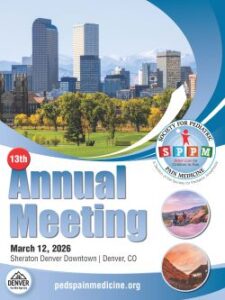![]()
Friends,
In the words of our motto, SPPM as an organization is dedicated to “Better Care of Children in Pain.” The work we do to advance pediatric pain management makes a difference in the lives of our patients and their families. It matters.
Today is Giving Tuesday, a day on which individuals and entities come together in charitable giving. As you plan your philanthropy, please consider donating to the SPPM Education and Research Fund. SPPM strives to make effective evidence-based pediatric pain management a priority and a reality. This is an ongoing effort, all the more important in this current time of polarization and misinformation. Our patients and their families need us.
Any contribution makes a difference, and promotes the important work of SPPM.
Click HERE to donate.
Many thanks!
Happy Holidays.
Stephen Hays, MS, MD, FAAP
SPPM President
 SPPM 13th Annual Meeting
SPPM 13th Annual Meeting